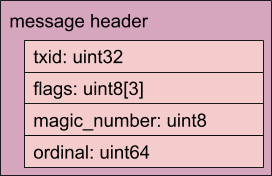| RFC-0037: Transactional message header v3 | |
|---|---|
| Status | Accepted |
| Areas |
|
| Description | This proposal modifies the FIDL wire format. The reserved bytes of the transaction header are allocated to a one byte magic number to identify the wire format used and three bytes for flags meant to be temporarily used for soft migrations. |
| Authors | |
| Date submitted (year-month-day) | 2019-03-07 |
| Date reviewed (year-month-day) | 2019-03-14 |
Summary
This proposal modifies the wire format as follows.
The reserved bytes of the transaction header are allocated to:
- A one byte magic number to identify the wire format used;
- And three bytes for flags meant to be temporarily used for soft migrations.
Additionally, rather than shoehorning epitaphs values in the header, an
epitaph payload is a struct{int32}.
Motivation and design
Having a magic number in headers:
- Provides a mechanism to readers whether a message received is compatible (or note), and symmetrically provide a mechanisn for writers to indicate the format of messages sent.
- Ordering of magic numbers is a non-goal, magic numbers should simply checked, and if not compatible (i.e. not supported), rejected. Specifically, we shy away from the term "version" since we want pairwise compatibility checks, and not range based compatibility as in "supports v5 through v8".
Having flags in headers:
- Provides a mechanism to help with soft transition, especially the requirement that bindings MUST NOT reject messages if they do not know about the use of certain flags, and instead just ignore them. For instance, this was used to migrate away from static unions.
- We prefer allocating more bytes to flags (3 bytes) than to magic numbers (1 byte) as we expect a lot more features to be temporarily needed, than wire format flavors.
On epitaph:
- Epitaphs were shoehorned into the
reservedbytes, which are now used for the magic number and the flags; - Having epitaphs be a plain vanilla payload
struct{int32}removes one special snowflake from the wire format, which typically simplifies bindings and reduces the likelihood of bugs or incompatibilities.
Lastly, we want to keep the header as small as possible, and it is an explicit goal to keep it at 16 bytes all the while supporting the additional requirements described above.
Evolution of Transactional Message Header
FIDL2 ("v2"):
- Transaction ID (
uint32) - Reserved (
uint32) - Flags (
uint32) - Ordinal (
uint32)
- Transaction ID (
uint32) - Reserved (
uint32) OR Epitaph value (zx.status) - Flags (
uint32) - Ordinal (
uint32)
- Transaction ID (
uint32) - Reserved (
uint32) OR Epitaph value (zx.status) - Ordinal (
uint64)
Initially, the reserved (uint32) field covering bytes 4 through 7 was meant to
align with requirements from zx_channel_call. However, the
syscall has stabilized, and this requirement is no longer needed.
Version 3
We stabilize the transactional message header ("v3") to be:
- Transaction ID (
uint32) - Flags (
array<uint8>:3, i.e. 3 bytes) - Magic Number (
uint8) - Ordinal (
uint64)
Bindings MUST NOT check flags, except for specific flags these bindings are using or know about, i.e. it is valid to set a bit that is unknown to recipient bindings.
As a wire format diagram we have:

When should a new magic number be assigned
The initial magic number will be 0x01. We reserve funnier numbers for later.
A magic number MUST be assigned to a new wire format when the wire format it is evolving or replacing cannot be reasonably phased out by the FIDL team.
Performance
Having epitaphs be struct{int32} payloads, rather than embedded in the
transaction header, increases the minimal amount of bytes read from 16 bytes to
24 bytes Performant bindings stack allocate a small buffer, and an increase of 8
bytes has minimal impact.
